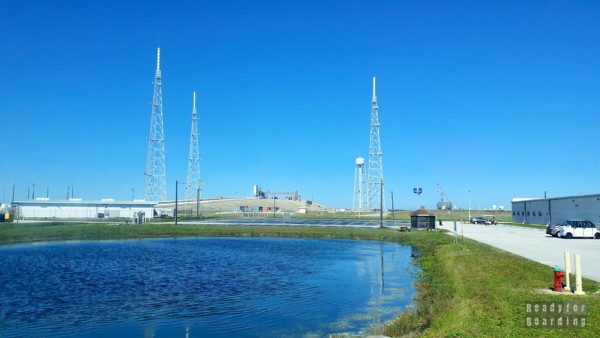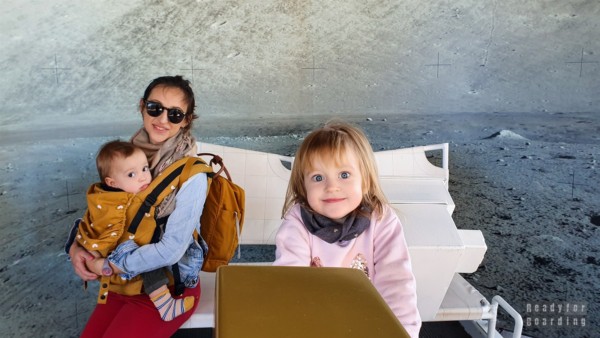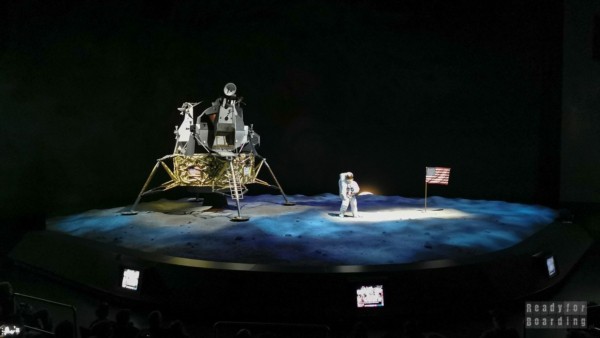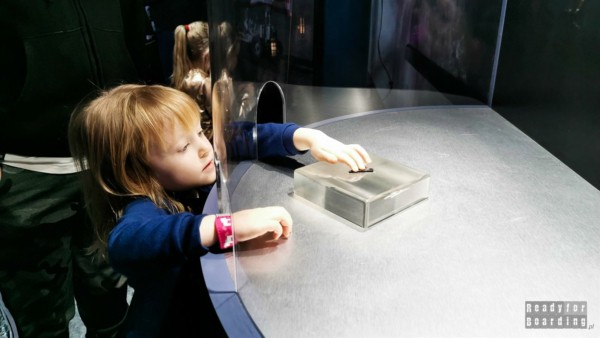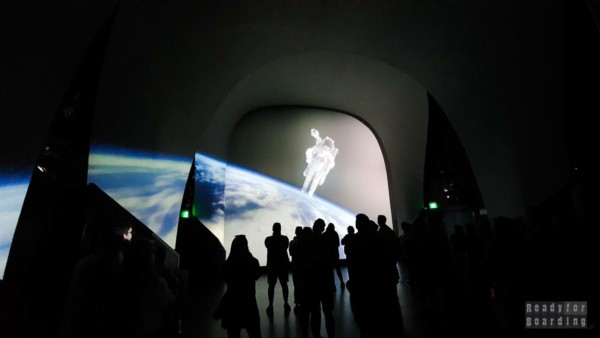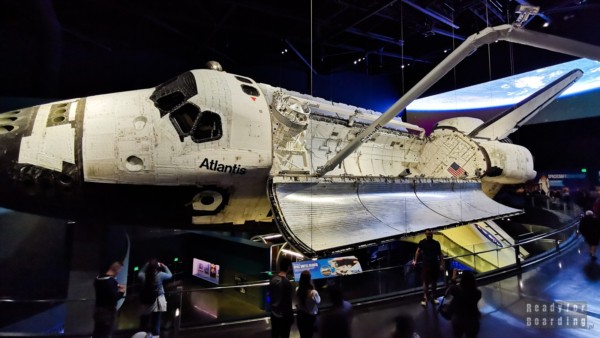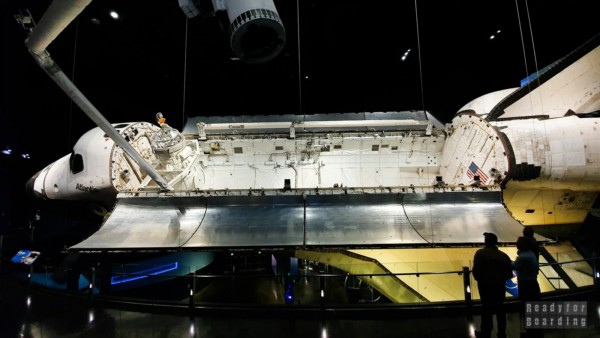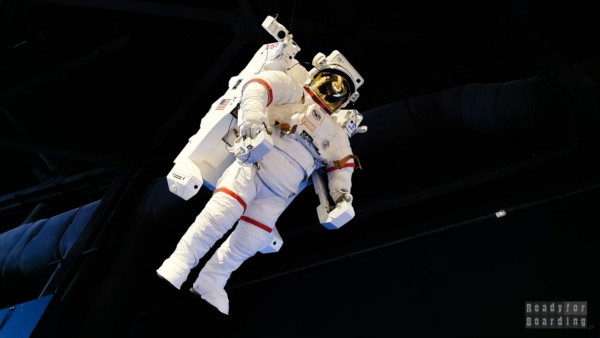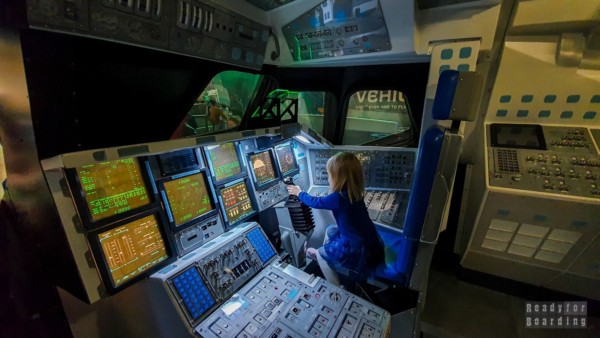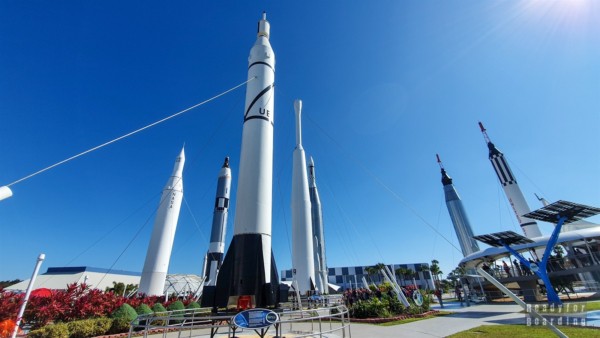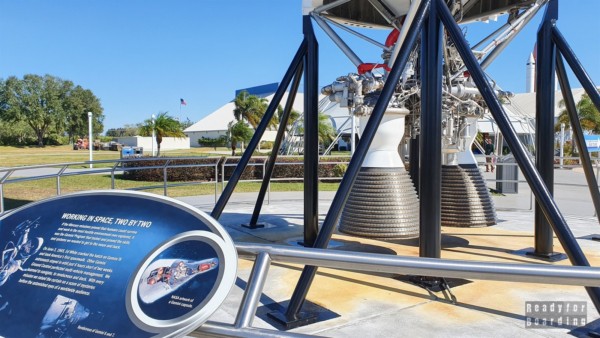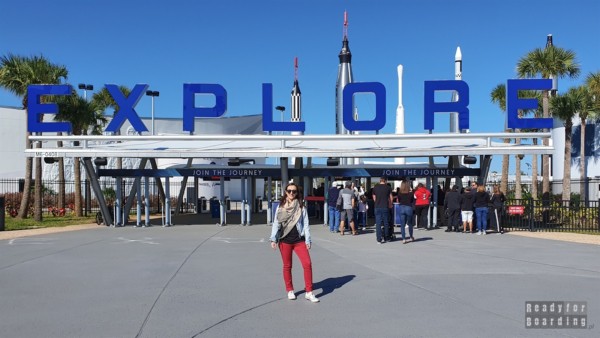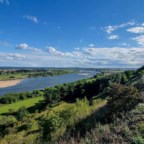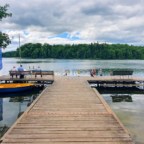If we were to point to one of the most interesting places to visit in Florida would definitely be the Kennedy Space Center and Cape Canaveral! We invite you to the place where spaceships take off from, where we will learn about the history of conquering space and even touch a real moon rock!
You probably associate Florida with wide beaches, beautiful sunsets, Sunshine Patrol, Caribbean climate or
Disneyland
… And we would like to recommend to you a very different place, perhaps less obvious to many people, but still very characteristic of the state.
The Kennedy Space Center is located at Cape Canaveral, on Florida’s east coast, about an hour’s drive from Orlando. It is on this cape that NASA’s base is located and spacecraft are launched from here. A visit to this place is quite a treat, not only for fans of space, rockets or shuttles. It’s a fantastic trip back in time, full of stories of space exploration, a chance to feel like an astronaut and even see a rocket launch!
Here we will learn about the past, learn about recent activities and missions, but also about plans for the near and distant future. And even though the price is a bit out of space (after all, the place is cosmic), we think a visit to KSC is worth every dollar spent.
Table of contents
Video of visit to Cape Canaveral
At the very beginning, we recommend you a video report of our stay at the Kennedy Space Center at Cape Canaveral. You can find the video at this link 🎬 Cape Canaveral, Florida, Kennedy Space Center on YouTube and below:
Kennedy Space Center tour
It’s worth noting right from the start that it’s not like you can walk around the entire facility at will. For visitors, there is a special complex with buildings inside which there are exhibitions, shows and even meetings with astronauts. In addition, visitors can board dedicated buses and go on a tour of the facility, during which they see the building where rockets are assembled (but only from the outside), the launch platforms and the building with exhibits dedicated to the missions to the moon (Apollo/Saturn V).
It is this tour that we recommend to you at the very beginning, as it is the shortest open (it closes 2 hours before the entire complex closes) and can only be accessed by buses traveling around the complex (you should reserve at least 2 hours for the trip, but we recommend up to 3 hours).
// Unfortunately, according to the website, bus rides are currently not taking place (due to the pandemic). Only rides to the Apollo/Saturn V Center are possible after booking a seat in advance. //January 2022
After entering through the gates, your eyes immediately see several buildings and models of rockets – there will be time for them and about what these objects hide we will write a little below, for starters let’s fly a bus to the moon!
The Kennedy Space Center Bus Tour
After passing the gates, walk towards the Atlantis building, to the plaza – Constelletion Plaza. Right next to the plaza is a bus stop, from where the buses carrying the most interesting objects at the Kennedy Space Center start for a tour. The buses leave quite often and there are quite a few of them, but there are even more people willing to take the tour ;) The queue goes smoothly, but we still waited more than 30 minutes before taking a seat on the bus.
Each coach has a guide who tells you about KSC, the sights you see, cites various amusing anecdotes and generally keeps you entertained on board. As a result, the trip flows quickly, there is an incredibly pleasant atmosphere and, of course, we are able to learn many interesting facts. The bus ride itself takes about 40 minutes.
The bus takes tourists towards the VAB (from Vehicle Assembly Building) – it is one of the largest buildings in the world (160 meters high)! On top of that, it has the largest doors and proudly hangs the largest American flag hung on the building. Yes, Great America – everything must be the best and biggest ;) By the way, the whole Space Center shows the power of America. Of course, there are also failures, mistakes, tragedies depicted, but the overall tone is that the Americans are doing the best job (and they are good at marketing, by the way).
Even though the bus doesn’t pull up in front of the VAB building itself, it’s still hugely impressive – after all, it’s not every day you get this close to where spacecraft are built. Let’s testify to how unique the building is at least two interesting facts: employees around the building often move bicycles, and in the 1960s, clouds would gather inside and rain would fall from them! Nowadays, powerful ventilation systems are operating inside, which have eliminated this problem, and employees do not have to arm themselves with umbrellas ;)
In addition to going around the building, the bus goes to the launch pads: Launch Pad 39A and Launch Pad 39B. The former was used to launch rockets as part of the Apollo program (yes, the one that was supposed to take man to the moon and bring him safely back to Earth) and the Space Shuttle. It is currently leased to SpaceX for commercial flights.
After seeing these places from behind the bus windows, there is a longer stop – Apollo/Saturn V Center.
Apollo/Saturn V Center – race to the moon
The Apollo and Saturn V Center is a separate complex dedicated to missions to the Moon. After exiting the bus, we have time to view the exhibitions on our own, and you can catch any return bus afterwards.
This is one of the places we remember most and most thoroughly. Why? Because it was here that we could almost feel like we were at a rocket launch, see what such a spacecraft actually looked like, how it was built, look at the history of space flight, and touch a piece of rock from the moon! But let’s go one step at a time :)
After entering the building, we waited a while to go into a room fully arranged to resemble space flight control. We sat on benches and counted down to the rocket’s launch. When the engines were fired up and she began to pound the air, the entire room almost began to shake, and the glass in the windows almost blew out. Almost, because, of course, it’s all just arranged to feel for yourself what rocket launches were like decades ago. After the lucky launch, visitors proceed to a huge hall, where in the central part hangs…. a rocket!
And not just any rocket, the first one. Above us hovered a giant Saturn V rocket – the largest rocket ever launched into space. Visitors can see it in all its glory, including a cross-section of it, as it is divided into several parts. Walking towards the tip of the rocket we hit the scene of the moon landing. This large display shows the Lunar Module, which was to have landed on the Moon during the Apollo 15 mission (it was eventually replaced by a lunar vehicle module).
Along the main hall, where the Saturn V hangs, there are smaller rooms with various exhibitions and displays showing the history of the Apollo program and many interesting facts about Earth’s natural satellite. Here you can admire rocks from the Moon, the capsule from the Apollo 14 mission, the astronauts’ outfits (exactly the ones that were on the Moon, still with moon dust), tools, prototypes, check-lists, flight logs, medals…. You can even touch a rock from the moon, and thanks to a projector that creates the moon’s surface, you can leave your own footprints on it.
Noteworthy among the rooms is also a section dedicated to the Apollo 1 mission, in which 3 astronauts lost their lives, and a performance showing the moon landing (in the waiting room you can move back to the 1960s and on a tiny cathode ray tube black and white TV await man’s first steps on the moon).
If by some miracle you have some time left here, there is the Moon Tree Garden outside with 12 trees commemorating the 12 Apollo missions and a bronze statue depicting the astronauts from the Apollo 11 mission (yes, it was this mission that landed happily on the moon and returned to Earth).
After visiting the Apollo/Saturn V Center, you return by bus to the main part of the center and can start (or continue) exploring the other parts.
Space shuttle Atlantis – space shuttles
Another exhibition that made an overwhelming impression on us was the one dedicated to shuttles. It is located next to the bus stop from which we started our bus trip, and it is impossible to miss: in front of the entrance is a huge fuel tank and rockets that carried the shuttles into space.
After passing them, one enters a room with a dome on which a film about the shuttles is projected. After the projection, the door to the next part opens and the truest shuttle appears to our eyes! We even have Atlantis at our fingertips, which flew from 1985 until 2011 (it was in that year that the shuttle flights were finally completed). The shuttle is tilted and open, allowing us to look inside.
The rest of the exhibition is a detailed exploration of these space shuttles – there are parts of them, parts for astronaut training, you can even sit in the pilot’s seat. Here we learn not only how the shuttle was built, but even see what and how the astronauts ate, and even how the space toilet worked. In addition to exhibits directly related to the shuttles, here you can see a replica of the Hubble telescope and learn about the International Space Station.
For children, the biggest attractions were the high slide, made to resemble a shuttle landing, and the entrance to the space station, full of narrow tunnels (adults can fit in too!).
For older kids and adults there is the Shuttle Launch Experience – a shuttle launch simulator (included in the ticket price).
Among these parts, full of excitement and smiles, there is one that urges you to pause and reflect – we are, of course, talking about the part dedicated to the tragic flights of Columbia and Challenger, in whose crashes all crew members (14 people in total) died. Sight piercing displays with personal belongings of astronauts.
Journey to Mars
It must be said that most exhibitions focus on what was. However, in the “Journey to Mars” pavilion we will learn what lies ahead. Of course, there is no shortage of Red Planet exploration history here, but significantly more emphasis is placed on plans and ideas for what’s next (not just in the context of Mars).
We, unfortunately, ran out of strength for this building and walked through it rather quickly, stopping only at the most eye-catching visuals, simulators and replicas of the Mars rover.
NASA Now + Next
Another pavilion and once again we are able to learn more about the future of spaceflight. Here we will see what the plans and visions are not only for the next few years, but also those more distant (also light ;)).
Heroes & Legends – an exhibition about heroes
This exhibit is located in the building just past the entrance to the Kennedy Space Center, on the left. We purposely left this part for the end in order to focus on those concerning shuttles and rockets, and unfortunately, being inside, we were already flying with the rest of our strength ;)
As the name suggests, inside we will meet American heroes. There is a dedicated room (the U.S. Astronaut Hall of Fame) showcasing American astronauts.
But they are not the only ones mentioned here. Part of the exhibit is devoted to the Mercury program, which aimed to put humans into orbit around the Earth.
Rocket Garden
We could write about them at the very beginning, as they are something that immediately strikes the eye upon entering the Kennedy Space Center site. And you can completely lose yourself here, because do you walk among 9 rockets every day!
Standing at the foot of them, you can see for yourself what technological wonders they are.
Kennedy Space Center for children
Is Kennedy Space Center a suitable place for families with children? Absolutely yes! Both adults and children will have a great deal of fun and pleasure here.
The opportunity to see rockets, leave footprints on the moon, enter the International Space Station, see the space flight command center – these are unique experiences that are sure to fire children’s imaginations.
We think that places like these are already attractive enough for children that you don’t need typical children’s attractions ;) However, if you’re looking for them, there’s a space playground in the complex, as well as (or especially) Planet Play – a large space where children can jump, run, go wild, and learn about the cosmos at the same time.
One note in this section, get ready for a lot of “Why?” questions when visiting the Kennedy Space Center ;) So it’s a good idea to introduce children to the topic of space exploration even before visiting here.
Additional attractions
As in other, educational places, you can also take part in various optional activities, workshops and even meetings with astronauts.
Unfortunately, we completely ran out of time for such attractions (and we were almost from opening to closing). Another point is that just staying and visiting the exhibitions is already a strongly intense experience, but if you plan to come here for two days, you can look at additional attractions.
What is worth considering? For example, meetings with astronauts. While the presentations are free, if you would like to meet them in a more intimate setting, you have to pay extra for that ($50 per adult and $35 per child, the price includes breakfast, an adult drink and a small gift such as an autographed photo).
In addition, Quest game, simulators or training are also paid (prices: link and link)
Rocket launch from Cape Canaveral – where to watch?
Since we are in a place where not only rockets are built, but also launched, how about seeing some rocket launches?
Unfortunately, it is not as simple as it may seem. You can’t just come to a rocket launch at the Kennedy Space Center at Cape Canaveral. Currently, it looks different every time. To watch the launch near the launch platforms you need to follow the information on the KSC website. Sometimes it is possible, sometimes not, and the information usually appears only a few days before (sometimes earlier). Sometimes you have to pay extra, and sometimes it’s included in the price of a regular ticket.
And you may be disappointed by what you read now, but don’t plan your stay in Florida under any particular rocket launch. There are too many factors determining such a launch, and they are too often postponed to be sure of hitting on just this particular one. If you’re really keen on it, check the KSC website to see what flights are scheduled(link) and preferably stay in the area for a longer period, or plan your stay so that you can flex it under the rocket launch.
We didn’t set our sights on anything, but we were quite lucky, because during our stay in Florida there was a scheduled launch of an Atlas V rocket carrying the Solar Orbiter probe (this launch has been postponed several times). What is the mission? The probe was created in cooperation between the European Space Agency and the U.S. NASA and is designed to study the Sun. That’s it in a nutshell, you can read more here.
Admittedly, we missed the date, as the launch was scheduled when we were already some three hours’ drive from Cape Canaveral, but how could we miss such an event?
So, we drove specifically those 3 hours to the start, which was scheduled for 11 pm, checking every now and then on the phone to see if they would cancel it at the last minute.
Driving we expected crowds…. Traffic jams on the highway, lack of parking spaces, crowded beach, but nothing like that happened. The fact that we were about an hour before the start, but we had no problem leaving the car right on the beach.
And which beach are you referring to? Well, one of the most popular places to observe rocket launches is Cocoa Beach. We stayed at the Westgate Cocoa Beach Pier, where there is car parking (free at night).
There was a great atmosphere on the beach – people arrived with chairs, deck chairs, spread blankets, opened beers and waited for the start.
At one point we saw a glow to the north, and a moment after that a large bright spot rose into the air. Only after a few seconds did the bang of the rocket’s launch (rather, the sound, the impact, not the bang) reach us. Then there was applause and cheering among all those waiting on the beach. You can see all the coverage in our YouTube video.
Was it worth driving 3 hours one way to see this launch? It may not have been the most spectacular, we didn’t see it up close, but we will probably never again in our lives see with our own eyes how a real rocket rises into the air! So YES, it was worth it!
Practical information
Here is some rather important practical information to help you better plan your day at Cape Canaveral’s Kennedy Space Center. The information is current as of the date of publication of this entry.
Organizing a visit to the Kennedy Space Center
We recommend reserving a full day for your stay in KSC. Inch! It is best to come for the opening, because not only is the area itself very large, but the number of attractions and engaging exhibitions is so large that, in our opinion, one day is not enough to see and experience everything.
Opening Hours:
Monday through Sunday – from 9:00 am to 5:00 pm.
Please note, the last bus that takes visitors to the Apollo/Saturn V Center leaves 2 hours before closing – this point we encourage you to do at the beginning rather than leaving it for the end, as you may run out of time.
Return buses from Apollo/Saturn V Center leave every 15 minutes, and the trip takes about 20 minutes.
Catering facilities
There are several food and beverage outlets at the Kennedy Space Center, serving both lunch dishes, snacks and sweets. These are not some very exquisite dishes, but the prices are cosmic (as, by the way, in all of Florida ;) ).
Something bigger and warm can be eaten at Orbit Cafe (near the bus stop) and Moon Rock Cafe (in the Apollo/Saturn V Center). These are mainly pizzas, burgers and salads.
Kennedy Space Center ticket prices
An all-day ticket for an adult costs $57, and for children aged 3-11 – $47, space, no? :)
So, the entrance fee for an example family of 2+2 is $208, or almost $850 (in our case a little cheaper, because one child was under 3 years old), but you know what? We do not regret any zloty (or rather dollar) spent, because it was a unique experience.
With these more than $200, we still need to mention the “symbolic” parking fee – $10 per day.
Getting to Cape Canaveral
The Kennedy Space Center can only be reached by car or by purchased tours from Orlando, for example.
Kennedy Space Center is located at Cape Canaveral, on the east coast of Florida, about 50 miles (about 80 kilometers) east of Orlando. It will take about an hour to get there by car from the city center, and take Route 50 toward Cape Canaveral, and then Route 405 to the bridge that takes you to the Cape. From here, it’s just a 10-minute drive to see the Kennedy Space Center on the right (turn right to reach the parking lot).
Accommodations near Kennedy Space Center
Of course, there are no hotels in the spaceflight center and there are no overnight accommodations here, but the close vicinity is teeming with places to stay. Prices start like this from 250 zloty per night, but it should be noted that these are heavily budgeted places.
Normally you have to calculate about 500 zloty per night.
Below are some examples of accommodations:
- Hampton Inn & Suites Cape Canaveral Cruise Port,
price about 700 zł per night for two people (breakfast included)
Link:
http://r4b.link/hampton-inn-suites-cape-canaveral
- Comfort Inn & Suites Melbourne-Viera,
a bit remote, but has very good reviews and a favorable price of about 415 zloty per night for two people (breakfast included)
Link:
http://r4b.link/holiday-inn-express-melbourne
- Aladdin Motel,
A typical American motel, price about 400 zloty per night for two people
Link:
http://r4b.link/aladdin-motel
We also recommend looking for accommodations closer to Orlando and treating it as a getaway spot, as there is plenty to do in the area.
Our review of the Florida space flight center
A visit to the Kennedy Space Center is a unique experience. Like nowhere else, we had the opportunity to feel the real thrill that accompanies both flight control and astronauts during a rocket launch. This is a huge dose of knowledge and an interesting experience, and a person leaving this place understands how big an undertaking each, single shuttle or rocket launch is.
Although the entrance is quite expensive it was some of the better spent money. We would literally recommend this place to anyone planning a stay in Florida :)
We also recommend you our post attractions in Miami!











